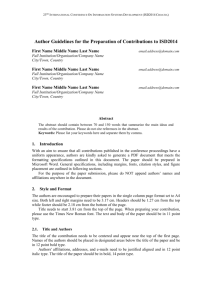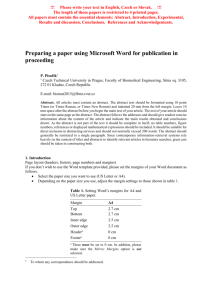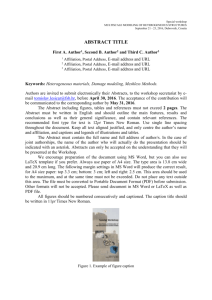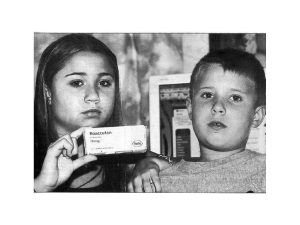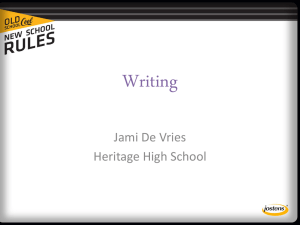- FET - Multimedia University
advertisement
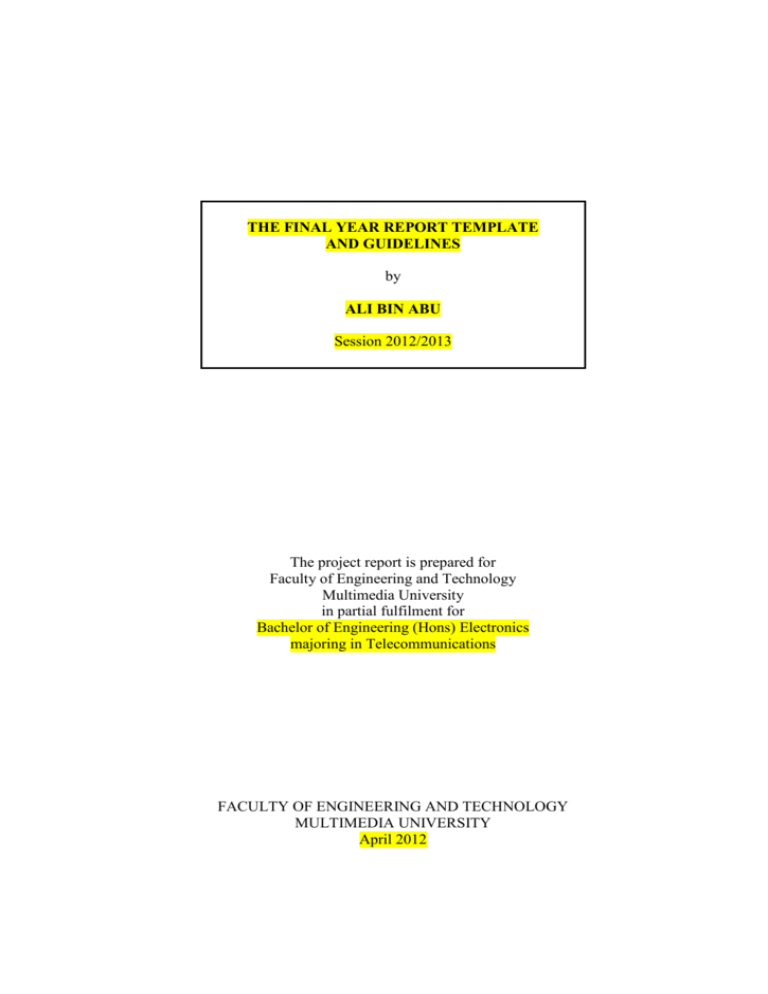
THE FINAL YEAR REPORT TEMPLATE AND GUIDELINES by ALI BIN ABU Session 2012/2013 The project report is prepared for Faculty of Engineering and Technology Multimedia University in partial fulfilment for Bachelor of Engineering (Hons) Electronics majoring in Telecommunications FACULTY OF ENGINEERING AND TECHNOLOGY MULTIMEDIA UNIVERSITY April 2012 The copyright of this report belongs to the author under the terms of the Copyright Act 1987 as qualified by Regulation 4(1) of the Multimedia University Intellectual Property Regulations. Due acknowledgement shall always be made of the use of any material contained in, or derived from, this report. ii DECLARATION I hereby declare that this work has been done by myself and no portion of the work contained in this report has been submitted in support of any application for any other degree or qualification of this or any other university or institute of learning. I also declare that pursuant to the provisions of the Copyright Act 1987, I have not engaged in any unauthorised act of copying or reproducing or attempt to copy / reproduce or cause to copy / reproduce or permit the copying / reproducing or the sharing and / or downloading of any copyrighted material or an attempt to do so whether by use of the University’s facilities or outside networks / facilities whether in hard copy or soft copy format, of any material protected under the provisions of sections 3 and 7 of the Act whether for payment or otherwise save as specifically provided for therein. This shall include but not be limited to any lecture notes, course packs, thesis, text books, exam questions, any works of authorship fixed in any tangible medium of expression whether provided by the University or otherwise. I hereby further declare that in the event of any infringement of the provisions of the Act whether knowingly or unknowingly the University shall not be liable for the same in any manner whatsoever and undertake to indemnify and keep indemnified the University against all such claims and actions. Signature: __________________________ Name: Student ID: Date: iii ACKNOWLEDGEMENT Insert acknowledgement here iv ABSTRACT Insert abstract here v TABLE OF CONTENTS Copyright ..................................................................................................................... ii Declaration .................................................................................................................. iii Acknowledgement....................................................................................................... iv Abstract ........................................................................................................................ v Table of Contents ........................................................................................................ vi List of Figures ............................................................................................................ vii List of Tables.......................................................................................................... viiivi CHAPTER 1: INTRODUCTION ................................................................................ 1 CHAPTER 2: SPECIFICATIONS OF THE REPORT ............................................... 2 2.1 Number of Copies ......................................................................................... 2 2.2 Cover and Binding......................................................................................... 2 2.2.1 Spine....................................................................................................... 2 2.3 Language ....................................................................................................... 3 2.4 Typeface and Font Size ................................................................................. 3 2.5 Paper and Printing ......................................................................................... 3 2.6 Margin and Spacing....................................................................................... 3 2.7 Pagination ...................................................................................................... 4 CHAPTER 3: FORMAT OF THE REPORT .............................................................. 5 3.1 Preliminary Pages .......................................................................................... 5 3.1.1 Title Page ............................................................................................... 5 3.1.2 Acknowledgement.................................................................................. 5 3.1.3 Abstract .................................................................................................. 6 3.1.4 Table of Contents and List of Figures/Tables ........................................ 6 3.2 Main Text ...................................................................................................... 6 3.2.1 Introduction ............................................................................................ 7 3.2.2 Theoretical Background or Review of Literature .................................. 7 vi 3.2.3 Method of Investigation or Details of the Design .................................. 7 3.2.4 Presentation of Data ............................................................................... 8 3.2.5 Discussion on Findings .......................................................................... 8 3.2.6 Conclusions and Recommendations ...................................................... 8 3.3 Reference Material ........................................................................................ 9 3.3.1 Appendices ............................................................................................. 9 3.3.2 References .............................................................................................. 9 3.4 General Guidelines ...................................................................................... 10 3.5 Further Reading ........................................................................................... 11 CHAPTER 4: INTELLECTUAL PROPERTY ......................................................... 12 4.1 Plagiarism – What is it?............................................................................... 12 4.2 Plagiarism Check ......................................................................................... 12 CHAPTER 5: FORMATTING TIPS ......................................................................... 14 5.1 Preliminary Pages ........................................................................................ 14 5.2 Headers ........................................................................................................ 14 5.3 Captions ....................................................................................................... 14 5.4 Citations and References ............................................................................. 16 REFERENCES........................................................................................................... 18 APPENDIX A ............................................................................................................ 19 vii LIST OF FIGURES Figure 3-1: MMU tagline ........................................................................................... 10 Figure 4-1: Class homepage at Turnitin.com ............................................................. 13 Figure 5-1: Dialog box for inserting captions ............................................................ 15 Figure 5-2: Referencing tables and figures ................................................................ 15 Figure 5-3: Dialog box for inserting citations ............................................................ 16 Figure 5-4: Editing reference sources ........................................................................ 17 viii LIST OF TABLES Table 2-1: Submission items ........................................................................................ 2 Table 2-2: Document margins ...................................................................................... 4 ix CHAPTER 1: INTRODUCTION The skill to apply engineering knowledge is one of the most important aspects that an engineering graduate must have acquired upon graduation. The only way to learn this practical skill is to have a specific engineering problem to solve. One must learn to use all applicable theories in analysing the problem systematically. Experimenting in a laboratory is essential. The process of experimentation involves organisation, observation, familiarisation with various pieces of equipment, working with others, writing and communicating ideas and information. These are the skills required of an engineer. Report writing is one of the primary professional responsibilities of a practising engineer. The final report of any project is not just a formality. It is a primary product of the engineering efforts and is often the basis for evaluation of the engineer’s professional abilities. The report is also a service to the engineering community who needs the information. The report should stand on its own. It is subject to critical analysis by a variety of readers. A report should include all the necessary sections, targeting at a reader who does not necessarily have any prior knowledge about the project. This guide is prepared to help the students in preparing their reports. To ensure the reports are easy to read with consistent format, it is important that students follow strictly the instructions during report preparation. CHAPTER 2: SPECIFICATIONS OF THE REPORT Candidates intending to submit their report should comply with the following procedures. Table 2-1: Submission items Items Submission of softcover report (2 copies) Submission of hardcover report (1 copy) & softcopy of report (1 copy in CD) 2.1 Deadline One week before first day of presentation sessions Two weeks after last day of presentation sessions Number of Copies For Project II, three printed copies of the report are to be submitted to the Faculty: a) Two copies shall be in softcover and submitted to the Faculty for examination. The softcover copies must be bound using black comb binding. The cover may be obtained from the Faculty office. One copy will be returned to the candidate later. b) One final copy shall be in hardcover and bound using PVC or other equivalent material. The sample of this cover is available at the library. One softcopy of the report (including the material in the appendices) must also be submitted in a CD along with the hardcover report. The CD label shall include the project title, name of author and submission date. 2.2 Cover and Binding The hardcover report shall be in maroon colour with gold lettering in the Arial Narrow typeface. A blank sheet of paper should be inserted before the title page and another blank paper should be attached before the back cover. 2.2.1 Spine 2 The name of the candidate, project title and year of report submission shall be set in uppercase, in the Arial Narrow typeface at font size 18. The direction of lettering should run from the top to the bottom of the spine. If the title of the report is too long to fit into the spine, ellipses should be inserted. For instance, a title like “EXERCISE MACHINE MOTIVATED BY INTEGRATED VIDEO GAME: USB TO HARDWARE CONNECTION” will not fit into the spine, and so should be shortened to “EXERCISE MACHINE MOTIVATED BY INTEGRATED VIDEO…” for the spine only. The front cover should still have the full title. 2.3 Language The report must be written in English. 2.4 Typeface and Font Size The Times New Roman typeface at font size 12 should be used in the main text throughout the report (except in the Appendices). This includes the preliminary pages (i.e., title page, declaration page, acknowledgement page, etc.) and the main body of text (which covers also the headers, captions and footers). Italics should only be used sparingly for emphasis. 2.5 Paper and Printing High-quality 80gm A4-size papers shall be used. The paper should be white in colour and acid-free. For printing, a laser or other high-quality printer is recommended. 2.6 Margin and Spacing The margin of the document must adhere to specifications in Table 2-2. The main text should be left-justified, with a line spacing of one and a half. For captions, single 3 spacing may be used. A blank line should be placed between different sections/subsections. The second paragraph and subsequent paragraphs should be indented in the first line. Table 2-2: Document margins Position Top Bottom Left Right 2.7 Margin (in mm) 20 40 40 25 Pagination Page numbers should be centered to the page, and placed at least 15 mm from the bottom edge of the page. Every page except the title page must be numbered. The preliminary pages (except the title page) are to be numbered in lower case Roman numerals. The other pages are to be numbered in Arabic numerals. All pages must be numbered consecutively and continuously. 4 CHAPTER 3: FORMAT OF THE REPORT A report shall normally have three sections, namely the preliminary pages (or the front matter), the main text (or the body matter), and the reference material (or back matter). 3.1 Preliminary Pages The preliminary pages should include the following pages according to the given order: Title page Copyright Declaration Dedication (optional) Acknowledgement Abstract Table of Contents List of Figures List of Tables 3.1.1 Title Page The title shall be capitalised. The title page number is not to be printed. The submission month/year should be the month/year corresponding to the submission deadline of the softcover report. 3.1.2 Acknowledgement This section contains a brief acknowledgement of the support and assistance given to the candidate throughout his/her work. 5 3.1.3 Abstract An abstract is the summary of the report which contains the statement of what was done, how it was done, the results and the conclusions drawn. It should not be used to define the purpose of the experiment or to give a general introduction. It should be short and concise, containing only the most critical information meant for the readers who have limited time to read the full report. Very often, technical professionals only read the abstract and will continue reading the entire report only if the abstract attracts their interest. It is normally limited to 300 words. 3.1.4 Table of Contents and List of Figures/Tables A Table of Contents is a list of the parts of a book or document organized in the order in which the parts appear. The Table of Contents should include the titles of the first-, second- and third-level headers (i.e., chapter, section and subsection titles). The Table of Contents helps orient the reader toward specific parts of the document, as well as providing the reader an idea of the scope of the document. With a similar purpose as the Table of Contents, the List of Figures/Tables helps readers locate the illustrations, diagrams, charts, and tables in the report. Figures and tables must be numbered consecutively in their order of appearance, and the numbering should be reset for each chapter. 3.2 Main Text The main text normally comprises the following chapters1: 1 Chapter 1: Introduction Chapter 2: Theoretical Background or Review of Literature Chapter 3: Method of Investigation or Details of the Design Chapter 4: Presentation of Data Chapter 5: Discussions on Findings The list of chapters given here is just an example, and need not be strictly followed. 6 Chapter 6: Conclusions and Recommendations Typical length of the main text should be around 50 to 100 pages. 3.2.1 Introduction An introduction is necessary to give an overview of the overall work and the purpose of the report. The general motivation behind the work should also be included. The content of the introduction should be general enough to introduce the reader to the subject matter. 3.2.2 Theoretical Background or Review of Literature This section discusses the theoretical aspects leading to the implementation of the project. Typically, this involves the historical background of the theories published in the literature and the gaps of knowledge or ambiguities that arose in these works. Citations for the sources of information should be given in the standard bibliographic formats (using square brackets with the corresponding number [1] that points to a particular item in the References). Avoid reporting irrelevant issues here. Depending on the length and complexity of the subject, the introduction and the theoretical background may be combined into one introductory chapter. 3.2.3 Method of Investigation or Details of the Design The project may generally be grouped into one of the following nature: a) Experimental research b) Design synthesis of hardware/software c) Development and application of theory For experimental research, explanations shall be given with regard to the equipment used to conduct the experiment, the function of each apparatus, the configurations in performing a particular measurement, sources of errors and how to 7 minimise them, the material and the ways to produce the sample. For design synthesis of hardware/software, the detailed descriptions of the techniques used shall be given. For development and application of theory, the detailed descriptions of the techniques used shall also be given. Mathematical derivations that are too lengthy shall be given in the appendices. Experiments conducted to verify the theory shall also be clearly documented. Depending on the nature of the project, this section may be divided into one or more chapters. 3.2.4 Presentation of Data The data should be organised and presented using graphs, charts, or tables in this section, without interpretative discussion. Raw data which may take up a few pages, and most probably do not interest any readers, can be placed in the appendices. 3.2.5 Discussion on Findings The interpretation of the data gathered should be discussed in this section. Sample calculations may be included to show the correlation between the theory and the measurement results. If there is any discrepancy between the theoretical and experimental results, an analysis or discussion should follow to explain the possible sources of error. In some cases, the presentation of data and discussions may also be combined into a single chapter. 3.2.6 Conclusions and Recommendations The conclusion section closes the report by providing a summary of content of the report. It should highlight the main contributions of the work and its significance, and the advantages and limitations of the information presented. Additional discussion should not be added. The potential applications of the results and recommendations for future work may be included. 8 3.3 Reference Material The reference material typically consists of: Appendices References 3.3.1 Appendices This section contains the lengthy material which is not appropriate for inclusion in the main text. Typical examples include raw data, programme code scripts, and equipment/device specifications sheet. The appendices should be set in the Times New Roman typeface at font size 10. 3.3.2 References Every reference quoted or cited in the report must be included in the References, and numbered accordingly. Citation is normally required for statements which express a fact that goes beyond the common knowledge of the art. The items in the References should be numbered according to the order in which they are cited in the text, and the numberings should be placed within square brackets. Refer to IEEE citation reference for the complete reference style2. Some examples are also given in the References section at the end of this document for books [1] [2], theses [3], journal articles [4] [5], and conference proceedings [6] [7]. Avoid URL references. If you must refer to websites, refer only to authoritative websites like the official websites of professional bodies or governments, or websites of companies describing their products, or online technical papers. Examples of nonauthoritative websites include Wikipedia and blogs. 2 The IEEE citation reference is available online at http://www.ieee.org/documents/ieeecitationref.pdf. 9 3.4 General Guidelines A report should be written according to the intended group of readers in mind. It should have a logical flow with strong explanation to convince the reader on the conclusions of the report. It should be well-written and should provide easy understanding. Excessive use of technical jargons and slang should be avoided. As far as possible, statements should be supported by relevant and accurate facts, data and numbers. Symbols or nomenclature used shall be defined. Standard symbols or acronym normally accepted in engineering field can be used. International System Unit (S.I.) shall be used. Equations should be typed clearly using the built-in equation editor, and sequentially numbered within the chapter. An example is below3: 3 3 𝑥3 26 ∫ 𝑥 𝑑𝑥 = [ ] = 3 1 3 1 2 (3.1) Every figure should be sequentially numbered, and the numbering should be reset for each chapter. Every figure should also carry a relevant caption that appears below the figure. An example is below: Figure 3-1: MMU tagline Like figures, tables should be sequentially numbered within the chapter, and labelled with a relevant caption. Unlike figure caption, table caption should appear above the table. 3 The table border lines are grayed out to show that a table has been used as a placeholder of the equation and the equation numbering. The border lines should be removed entirely before printing the report. 10 3.5 Further Reading More guides and information in preparing engineering reports as well as other technical documents may be found in [8] [9]. 11 CHAPTER 4: INTELLECTUAL PROPERTY The candidate must adhere to the provisions of the Intellectual Property Regulations of the University. 4.1 Plagiarism – What is it? Proper acknowledgement must be made to the work of others. Plagiarism includes: a) Unauthorized act of copying/reproducing or attempt to copy an idea, writing or invention of another person b) Extraction of academic data which are the results of research undertaken by another person, such as laboratory findings, data obtained, whether published or unpublished, without giving due acknowledgement to the original source c) Transcription of the ideas of others which are kept in whatever form d) Unauthorized translation of the writing of another person from one language to another whether wholly or partly 4.2 Plagiarism Check The candidate shall be required to submit their report to Turnitin.com (at http://www.turnitin.com/), and submit the generated originality report and the Similarity Index Form to the supervisor for endorsement. Both these documents are to be submitted separately with the softcover report during examination. An email invitation will be sent to you to log into Turnitin.com. Once logged in, click on the class enrolled to open the class homepage (see screenshot of Figure 4-1). Here, you will be able to submit your report, by the chapter, by clicking on the Submit button. Once the report is processed, the similarity index (in percentage) would appear. Clicking on these scores would open the originality report, detailing the similarity percentages by the sources, and highlighting also the portions of the report coinciding with these sources. The percentages should be recorded in the 12 Similarity Index Form, and justifications must be provided for similarity index above 10%. Figure 4-1: Class homepage at Turnitin.com 13 CHAPTER 5: FORMATTING TIPS 5.1 Preliminary Pages The preliminary pages have been set properly for your use, and only those parts highlighted in yellow should be amended. The rest should be left as it is. 5.2 Headers To insert a chapter header, simply create one, and apply the Heading 1 style of the Styles gallery in the Home tab. This will set the text in bold. For section headers, use Heading 2 instead, whereas for subsections, choose Heading 3. The header numberings will be generated automatically. For the headers to appear in the Table of Contents, select the Table of Contents and click on Update Table (under Table of Contents) in the References tab. 5.3 Captions To insert a caption in a figure or table, select the item, and click Insert Caption under the References tab. This will open a dialog box (see Figure 5-1), in which you may choose the position of the caption. Figure captions should appear below the figure, whereas table captions should appear above the table. Click OK and the caption will appear at the chosen position. Like headers, caption numberings are generated automatically. Lastly, insert the text, and then center the caption to the page. For captions to appear in the List of Figures or List of Tables, select the respective list and click on Update Table (under Captions) in the References tab. 14 Figure 5-1: Dialog box for inserting captions To reference to a particular figure or table, place the cursor on where you want the reference label to appear. Then, click Cross-reference under the References tab. In the dialog box that appears (see Figure 5-2), choose the appropriate Reference type. For figures and tables, pick Only label and number for the Insert reference to option. Figure 5-2: Referencing tables and figures 15 5.4 Citations and References To insert a citation to a new source, place the cursor on where you want the citation to appear in the main text. Then, click Insert Citation under the References tab, and choose Add New Source…. A dialog box will appear as in Figure 5-3. Pick the appropriate Type of Source, and tick the Show All Bibliography Fields checkbox. Fill in all related information in their respective fields. Click OK and the citation will appear. For the references to appear in References, select References and click Update Citations and Bibliography. Figure 5-3: Dialog box for inserting citations At any time if you need to edit the source, you may click Manage Sources to do so (see Figure 5-4). 16 Figure 5-4: Editing reference sources 17 REFERENCES [1] L. R. Rabiner and B.-H. Juang, Fundamentals of Speech Recognition, PrenticeHall, 1993. [2] G. H. Golub and C. F. Van Loan, Matrix Computations, 3rd ed., The John Hopkins University Press, 1996. [3] P. S. K. Hansen, "Signal subspace methods for speech enhancement," Ph.D. dissertation, Technical University of Denmark, 1997. [4] J. Rissanen, "Modeling by shortest data description," Automatica, vol. 14, no. 5, pp. 465-471, 1978. [5] S. H. Jensen, P. C. Hansen, S. D. Hansen and J. A. Sørensen, "Reduction of broad-band noise in speech by truncated QSVD," IEEE Trans. Speech and Audio Processing, vol. 3, no. 6, pp. 439-448, 1995. [6] K. Hermus and P. Wambacq, "Assessment of signal subspace based speech enhancement for noise robust speech recognition," in IEEE International Conference on Acoustics, Speech, and Signal Processing, Montreal, 2004. [7] T. Takiguchi, J. Adachi and Y. Ariki, "Audio-based video editing with twochannel microphone," in International Conference on Multimedia and Ubiquitous Engineering, Busan, 2008. [8] D. Beer and D. McMurrey, A Guide To Writing As An Engineer, John Wiley & Sons, 1997. [9] J. Lannon, Technical Writing, 6th ed., HarperCollins College Publishers, 1993. 18 APPENDIX A Sample of spine and front cover of the report 20mm from the top of the spine Typeface: Arial Narrow Font size: 18 ALI BIN ABU 50mm from the top of the page 45mm from the left margin THE FINAL YEAR REPORT TEMPLATE AND GUIDELINES THE FINAL YEAR REPORT TEMPLATE AND GUIDELINES ALI BIN ABU 1011123456 2012/2013 MULTIMEDIA UNIVERSITY APRIL 2012 2012/2013 50mm from the bottom of the page 20mm from the bottom of the spine 19 45mm from the right margin
